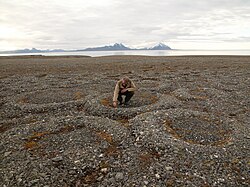Frost heaving
Frost heaving is the lifting of frozen soil, caused by water rising from below to the level in the soil where it freezes, accumulates as ice, and pushes the soil above it upwards.[1]
Frost Heaving Media
- Anatomy of a frost heave during spring thaw. The side of a 6-inch (15-cm) heave with the soil removed to reveal (bottom to top):*Photograph taken 21 March 2010 in Norwich, Vermont
- Needle ice, which has extruded up from the freezing front through porous soil from a water table below
- Coalesced ice-rich soil, which has been subject to freeze-thaw
- Thawed soil on top
Frost heaves on a rural Vermont road during spring thaw
Partially melted and collapsed lithalsas (heaved mounds found in permafrost) have left ring-like structures on the Svalbard Archipelago
Related pages
References
- ↑ Taber, Stephen (1930). "The mechanics of frost heaving". Journal of Geology. 38 (4): 303–317. Bibcode:1930JG.....38..303T. doi:10.1086/623720. S2CID 129655820. Archived from the original (PDF) on 2013-04-08. Retrieved 2017-07-14.




